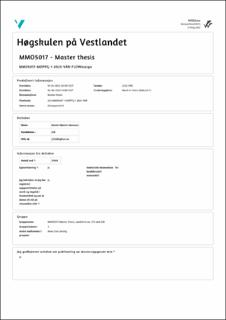| dc.description.abstract | As of recent IMO committed that the next big deadline is set to be in 2050 for the shipping industry, by this time all emissions must be halved. To meet the future emission demands which are set by the IMO; the shipping companies, class companies, maritime authorities, etc. must take action for facilitating that new carbon-neutral alternative fuels can be implemented. These alternative fuel types can be such as green ammonia, methanol, hydrogen, Thorium Molten Salt Reactor, and to some extent, LNG (liquefied natural gas). However, some challenges must be solved, to make the fuels a viable option.
For this reason, alternative fuels were further researched to broadly understand how the fuel can be implemented as a solution to reduce emissions. Through an extensive literature review, the technical and operational aspects such as its availability and infrastructure, emission, fuel consumption, economic feasibility, and technical storage capacity were investigated. Also, regarding the calculations and the operational aspect MS Nordlys from Hurtigruten was considered as the vessel to be opted for use for these alternative fuels, as it is today sailing regularly along the Norwegian coast. The alternative fuels were compared together with the base case Marine Diesel Oil. This fuel is regarded as the most common fuel in Norway, accompanied by LNG which is a more available environmentally friendly option as of today. LNG is considered a bridging fuel, which can in the short term reduce the emissions, but is still regarded as a fossil fuel that needs to be replaced with a more environmentally friendly option in the future. The risk of each fuel type was examined regarding the properties of the fuel itself, and how this constitutes a risk in an operational aspect.
It is seen in this context that for the new fuel types, several of them are not ready for the market as it is today. There is a lot of work that remains when it comes to further technological development and research before it can be ready for implementation as a usable operational solution that can help reduce fuel emissions. This also applies to developing infrastructure that can take care of the bunkering needs of coastal ships. The shipping companies might as of now hesitate to make a switch to more environmentally friendly options due to the vast competition in the shipping market when it comes to the
current price level of acquisition for the alternative fuels. Onshore installations to produce these fuel types must also be developed before they can be considered a competitive option. With established infrastructure, this can also bring down the acquisition cost of the fuels in question. Although most of the alternative fuels investigated seems promising if it is further researched and developed, in this report, it was found that green methanol and thorium molten salt reactor seems even more interesting. Green methanol on the other hand has zero emissions if the CO2 is stored and re-used for the production of new methanol, accompanied by hydrogen from renewable sources such as wind- or solar power. As for the thorium molten salt reactor, the road is barely begun. With its vast energy density and very low thorium consumption for power generation it can operate for a very long time. It is undoubtedly something that should be prioritized for research and development, and it is also regarded a safe option.
Norway seems to be on a good path in research and development when it comes to the alternative fuels investigated. With the downside of thorium molten salt reactors not being researched. Furthermore, more funds must be allocated to reach the emissions goals as set by IMO. | en_US |

